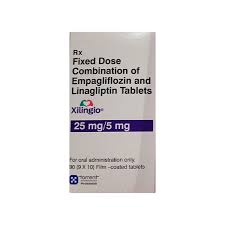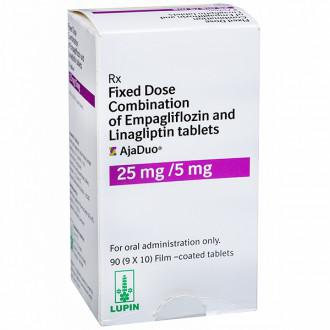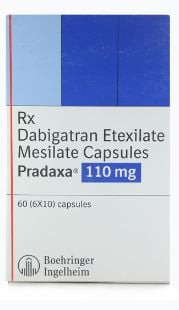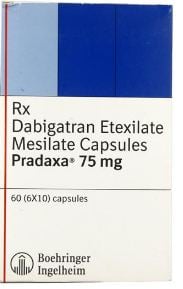Glyxambi 25mg/5mg Tablet 10s EMPAGLIFLOZIN + LINAGLIPTIN
Glyxambi 25mg5mg Tablet is a medication combination designed to regulate blood sugar levels It is intended for use in conjunction with a balanced diet and regular exercise to enhance blood sugar control in adults diagnosed with type 2 diabetes mellitus This medication aids in the effective utilization of insulin ultimately reducing blood sugar levels Glyxambi 25mg5mg Tablet can be taken with or without meals at any time of the day However it is recommended to take it at the same time each day The dosage will be determined by your healthcare provider It is important not to discontinue the medication without consulting your doctor as doing so may lead to elevated blood sugar levels and increase the risk of severe complications such as kidney damage and vision impairment Remember this medication is just one component of a comprehensive treatment plan that includes a healthy diet regular exercise and weight management all as per your doctors guidance Before starting this medication inform your doctor if you have kidney or liver issues a urinary tract infection or if you are taking diuretics water pills If you are pregnant or breastfeeding it is essential to consult with your doctor before taking Glyxambi 25mg5mg Tablet Additionally it is advisable to avoid excessive alcohol consumption while on this medication as this may heighten the risk of experiencing certain side effects Lastly make sure to monitor your blood sugar levels regularly while taking this medication

Are the medicines in combination of Empagliflozin and Linagliptin safe to take together?
Empagliflozin and Linagliptin, when used together, do not have significant drug-drug interactions with each other, as they work through different mechanisms. However, when combined with other medications, they can interact with drugs that affect blood sugar levels, such as insulin or sulfonylureas, increasing the risk of hypoglycemia. Monitoring involves regular blood sugar testing and adjusting doses of insulin or other diabetes medications as needed. Healthcare providers may also monitor kidney function and hydration status, especially if the patient is taking diuretics or has renal impairment, to prevent dehydration and other complications.

Are there harms and risks from taking combination of Empagliflozin and Linagliptin?
Common side effects of Empagliflozin include increased urination and thirst, while Linagliptin may cause symptoms like a stuffy or runny nose, sore throat, and cough. Both medications can lead to changes in blood sugar levels, and patients should be aware of the symptoms of both low and high blood sugar. Serious adverse effects include urinary tract infections, pancreatitis, and ketoacidosis. Empagliflozin may increase the risk of lower limb amputation and dehydration, while Linagliptin can cause severe joint pain and skin reactions. Patients should report any severe or persistent side effects to their healthcare provider immediately.

Can I take combination of Empagliflozin and Linagliptin if I am pregnant?
Empagliflozin and Linagliptin are not recommended during pregnancy due to potential risks to the developing fetus. Empagliflozin has shown adverse renal effects in animal studies, particularly during the second and third trimesters, which correspond to critical periods of renal development in humans. Linagliptin's effects during pregnancy are not well studied, but caution is advised. Poorly controlled diabetes during pregnancy can lead to complications, so alternative treatments that are safer during pregnancy are usually recommended. Pregnant women should discuss their treatment options with their healthcare provider to ensure the best outcomes for both mother and child.

Can I take combination of Empagliflozin and Linagliptin while breastfeeding?
The safety of Empagliflozin and Linagliptin during lactation and breastfeeding is not well established. Empagliflozin is present in rat milk, and there is a potential risk to the developing human kidney, as human kidney maturation occurs during the first two years of life. Therefore, it is not recommended to breastfeed while taking Empagliflozin. Linagliptin's presence in human milk is also not well studied, and caution is advised. Healthcare providers typically recommend alternative treatments or advise against breastfeeding while on these medications to avoid potential risks to the infant.

Can I take combination of Empagliflozin and Linagliptin with other prescription drugs?
Empagliflozin and Linagliptin can interact with several prescription medications. Empagliflozin may increase the risk of dehydration when taken with diuretics and can enhance the effects of insulin or insulin secretagogues, increasing the risk of hypoglycemia. Linagliptin's effectiveness can be reduced by strong inducers of CYP3A4 or P-gp, such as rifampin. Both medications require careful monitoring when used with other drugs that affect blood sugar levels. Patients should inform their healthcare provider of all medications they are taking to manage potential interactions effectively.

For how long is combination of Empagliflozin and Linagliptin taken?
Empagliflozin and Linagliptin are typically used as long-term treatments for managing type 2 diabetes. They are not cures for diabetes but are intended to help control blood sugar levels over time. Patients are usually advised to continue taking these medications as part of their daily routine, alongside lifestyle changes such as diet and exercise, unless otherwise directed by their healthcare provider. Regular monitoring and consultations with a healthcare provider are essential to assess the effectiveness and adjust the treatment as needed.

How does combination of Empagliflozin and Linagliptin work?
Empagliflozin works by inhibiting the sodium-glucose co-transporter 2 (SGLT2) in the kidneys, which reduces glucose reabsorption and increases glucose excretion in the urine, thereby lowering blood sugar levels. Linagliptin, a dipeptidyl peptidase-4 (DPP-4) inhibitor, increases the levels of incretin hormones, which enhance insulin secretion and decrease glucagon levels in a glucose-dependent manner. Together, these medications provide a dual mechanism to effectively manage blood sugar levels in patients with type 2 diabetes, addressing both insulin regulation and glucose excretion.

How does one take combination of Empagliflozin and Linagliptin?
Empagliflozin and Linagliptin can be taken with or without food, typically once daily in the morning. It is important to take the medication at the same time each day to maintain consistent blood levels. Patients should follow their healthcare provider's dietary recommendations, which often include a balanced diet to help manage diabetes. While there are no specific food restrictions directly related to these medications, maintaining a healthy diet and staying hydrated is crucial. Patients should also avoid excessive alcohol consumption, as it can affect blood sugar levels and increase the risk of dehydration.

How do I know if combination of Empagliflozin and Linagliptin is working?
The benefits of Empagliflozin and Linagliptin are primarily assessed through regular monitoring of blood sugar levels, including fasting blood glucose and HbA1c tests, which provide an average blood sugar level over the past two to three months. Additionally, the reduction in the risk of cardiovascular events, such as heart attacks and strokes, is an important measure of benefit, particularly for Empagliflozin. Patients may also be monitored for improvements in kidney function and overall health outcomes related to diabetes management. Regular follow-ups with healthcare providers help ensure the medications are effectively managing the condition.

How do I store combination of Empagliflozin and Linagliptin?
Empagliflozin and Linagliptin do not require refrigeration. They should be stored at room temperature, between 68°F to 77°F (20°C to 25°C), and kept in their original container, tightly closed, to protect them from moisture and heat. It is important to keep these medications out of reach of children and pets. They should not be stored in the bathroom, as the humidity can affect the medication's stability. Proper storage ensures the medication remains effective throughout its shelf life.

How effective is combination of Empagliflozin and Linagliptin?
Clinical trials have demonstrated the effectiveness of Empagliflozin and Linagliptin in managing type 2 diabetes. Empagliflozin has been shown to significantly reduce blood sugar levels and lower the risk of cardiovascular death in patients with type 2 diabetes and cardiovascular disease. It also helps in reducing the risk of hospitalization for heart failure. Linagliptin effectively lowers blood sugar by increasing incretin hormone levels, which enhance insulin secretion. Together, these medications provide a synergistic effect, improving glycemic control and reducing the risk of diabetes-related complications. The combination has been well-studied and is supported by evidence from multiple clinical trials.

How long does it take for combination of Empagliflozin and Linagliptin to work?
Empagliflozin and Linagliptin, when used together, start working relatively quickly to lower blood sugar levels. Empagliflozin begins to increase urinary glucose excretion soon after ingestion, typically within hours, as it inhibits the reabsorption of glucose in the kidneys. Linagliptin, on the other hand, works by increasing the levels of incretin hormones, which help to regulate insulin and glucagon levels, thereby lowering blood sugar. While the exact time frame for noticeable effects can vary among individuals, both medications generally start to show their effects within a few days of consistent use. However, the full therapeutic benefits, especially in terms of long-term blood sugar control, may take several weeks to become evident.

What disease or symptom is combination of Empagliflozin and Linagliptin used for?
Empagliflozin and Linagliptin are indicated for the management of type 2 diabetes in adults. Empagliflozin is also used to reduce the risk of cardiovascular death in adults with type 2 diabetes and established cardiovascular disease. Additionally, it helps in reducing the risk of hospitalization for heart failure and worsening kidney disease. Linagliptin is primarily used to improve glycemic control in type 2 diabetes. Together, they provide a comprehensive approach to managing blood sugar levels and reducing the risk of diabetes-related complications.

What is combination of Empagliflozin and Linagliptin?
Empagliflozin and Linagliptin are used together to manage blood sugar levels in adults with type 2 diabetes. Empagliflozin works by inhibiting the sodium-glucose co-transporter 2 (SGLT2) in the kidneys, which increases glucose excretion in urine. Linagliptin, a dipeptidyl peptidase-4 (DPP-4) inhibitor, enhances the levels of incretin hormones, which help regulate insulin and glucagon. Together, they provide a complementary approach to lowering blood sugar levels and reducing the risk of cardiovascular complications.

What is the usual dose of combination of Empagliflozin and Linagliptin?
The usual adult daily dose for Empagliflozin is either 10 mg or 25 mg, depending on the patient's needs and response to the medication. Linagliptin is typically prescribed at a dose of 5 mg per day. When combined in a single tablet, the common dosages are 10 mg of Empagliflozin with 5 mg of Linagliptin or 25 mg of Empagliflozin with 5 mg of Linagliptin. Both medications are taken once daily, usually in the morning, and can be taken with or without food. The combination aims to enhance blood sugar control in adults with type 2 diabetes by utilizing the complementary mechanisms of action of both drugs.

Who should avoid taking combination of Empagliflozin and Linagliptin?
Empagliflozin and Linagliptin have several important warnings and contraindications. Empagliflozin is not recommended for patients with severe renal impairment or those on dialysis, as it may not be effective and can increase the risk of dehydration and ketoacidosis. Linagliptin should be used cautiously in patients with a history of pancreatitis. Both medications can cause serious allergic reactions, and patients should discontinue use and seek medical attention if they experience symptoms such as rash, swelling, or difficulty breathing. Additionally, patients should be aware of the risk of hypoglycemia, especially when used with insulin or insulin secretagogues.

















.svg)
